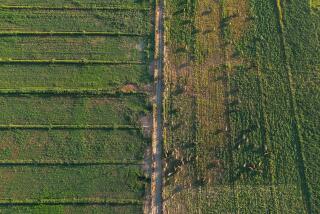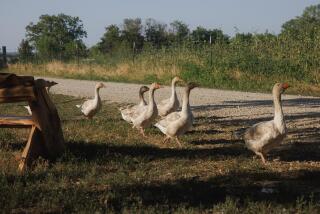Chemical Use on Farms Laid to U.S. Policies
- Share via
Federal agriculture policies keep American farms hooked on chemicals and are the major obstacle to widespread use of environmentally sound farming methods, the National Academy of Sciences said in a strongly worded report released Thursday.
In addition to blaming federal price supports for chaining farmers to chemical fertilizers and pesticides, the 448-page report praised alternative agriculture--a system that shuns chemicals and, instead, exploits biology to kill bugs and weeds and replenish the soil.
Quantity Given Priority
“As a whole, federal policies work against environmentally benign practices and the adoption of alternative agricultural systems,” said the report, which was written by the National Research Council, an arm of the academy. “These policies have generally made a plentiful food supply a higher priority than protection of the resource base.”
Although everyone from the U.S. Department of Agriculture to the American Farmland Trust supported the study Thursday, its findings were not universally applauded.
“We’re letting less than 1% of the farmers dictate social engineering in rural America,” Gary Myers, president of the Fertilizer Institute, said. “I think (the study) is a real insult to American agriculture and the American farmer. It really takes them for granted and says they don’t know what they’re doing when they apply things like fertilizer.”
Patrick Haggerty, spokesman for the National Agricultural Chemicals Assn., argued that farmers have always searched for alternative techniques and that, when they find feasible ones, they adopt them.
“What the overwhelming majority of farmers have chosen today as their form of agriculture is the judicious protection and management of their crops through the use of crop protection chemicals,” Haggerty said. “The moment a viable alternative to that comes up, they’ll stop using crop protection chemicals. That hasn’t happened yet.”
Chemical-free organic farming is only one of a long list of alternative farming practices. Among others are the rotation of crops to fortify soil and scouting for pests before automatically spraying with pesticides.
To John Pesek, chairman of the committee that wrote the report, the federal government’s culpability was the greatest discovery of the National Research Council’s five-year study.
“Agricultural commodity programs cover about 70% of the acreage of crops we grow,” Pesek said. “It is these programs that really restrict experimentation and the changing . . . to alternative crops or to rotation” or to other such practices.
The report said that farmers who want to switch to alternative growing practices must overcome stiff financial penalties first. And, because farming is a risky business even with subsidies, few are willing to make that change.
Between 80% and 95% of all American acreage producing wheat, cotton, rice and feed grains like corn is enrolled in federal commodity programs and receives subsidy payments from the government. The payments are based on a farmer’s average acreage and yield over a five-year period.
Take, for example, a farmer with all of his acres in corn for five years. If he switches half of his acreage to a legume--which will fortify the soil and reduce the need for certain fertilizers--fewer acres will be eligible for support payments, and the farmer will lose government money.
And, because the income of farmers in these programs depends on high yields, Pesek said, they use more chemicals to push their soil to the limit--”especially fertilizers in greater quantities than necessary, to get the highest potential base.”
In the past, Agriculture Department officials have been skeptical of alternative or “sustainable” agriculture methods. But, on Thursday, department officials went to great lengths to demonstrate that they support the alternative agriculture movement.
At 10 a.m., the National Academy of Sciences held a news conference to release its study. An hour later, Charles E. Hess, the assistant secretary of agriculture, praised the report.
“This report comes at the right time and at the right place,” Hess said. “I sense a change in the department” on the feasibility of alternative agriculture.
He said that there is a growing concern about “food safety” and “environmental sensitivity,” particularly regarding pesticides permeating the soil and running off into streams.
“You have a recognition now that the practices we have been using in the past have a downside,” Hess said. “We need to develop alternatives.”
He mentioned that “quite a few fruit and vegetable farmers in California” are moving to alternative agriculture methods, in part because of consumer fears about pesticides.
Tom Pavich, of Delano, Calif., is one such farmer. Pavich is a partner in Pavich Family Farms--one of 11 farms studied by the National Research Council in its look at alternative agriculture.
The Paviches have been growing table grapes in the San Joaquin Valley since 1953. They began using chemicals in the late 1960s, when synthetic pesticides and fertilizers came into widespread use on the American farm.
But, by 1970, the family decided to chuck its chemicals and find another way to farm.
“We were experiencing problems with quality,” Pavich said in an interview. “It was primarily due to the overuse of commercial fertilizers for our soil type. The water-holding capacity of soil was going down. The ability to hold nutrients seemed as if it was going down. We felt we weren’t getting the full benefits of our chemical fertilizer applications.”
The result: small, squishy grapes.
Although the switch to alternative agriculture helped the farm in the long run, the transition was fraught with problems. The Paviches made mistakes and could not rid their vines of a number of pests.
It took five years, for example, for the farmers to stamp out the Pacific red spider mite. During that time, the farm remained competitive, but growing natural predators to end the mite problem was a painstaking process.
“It would have been nice to have some research or some university help to assist us,” Pavich said.
That sentiment surfaced several times in the National Research Council report--most importantly in a recommendation that the government set aside at least $40 million annually for research into alternative farming methods.
The report said that research is necessary into such issues as crop rotation, the development of improved plant and livestock species and the economics of alternative agriculture--information that is at the heart of alternative farming and unavailable today.
“A shortage of public funds in support of agricultural research has discouraged work on alternative agriculture,” it said. “With shrinking funds, publicly supported research and extension services have not been able to provide adequate . . . information about alternative farming practices.
Maria L. La Ganga reported from Los Angeles and David G. Savage from Washington.
More to Read
Sign up for Essential California
The most important California stories and recommendations in your inbox every morning.
You may occasionally receive promotional content from the Los Angeles Times.












